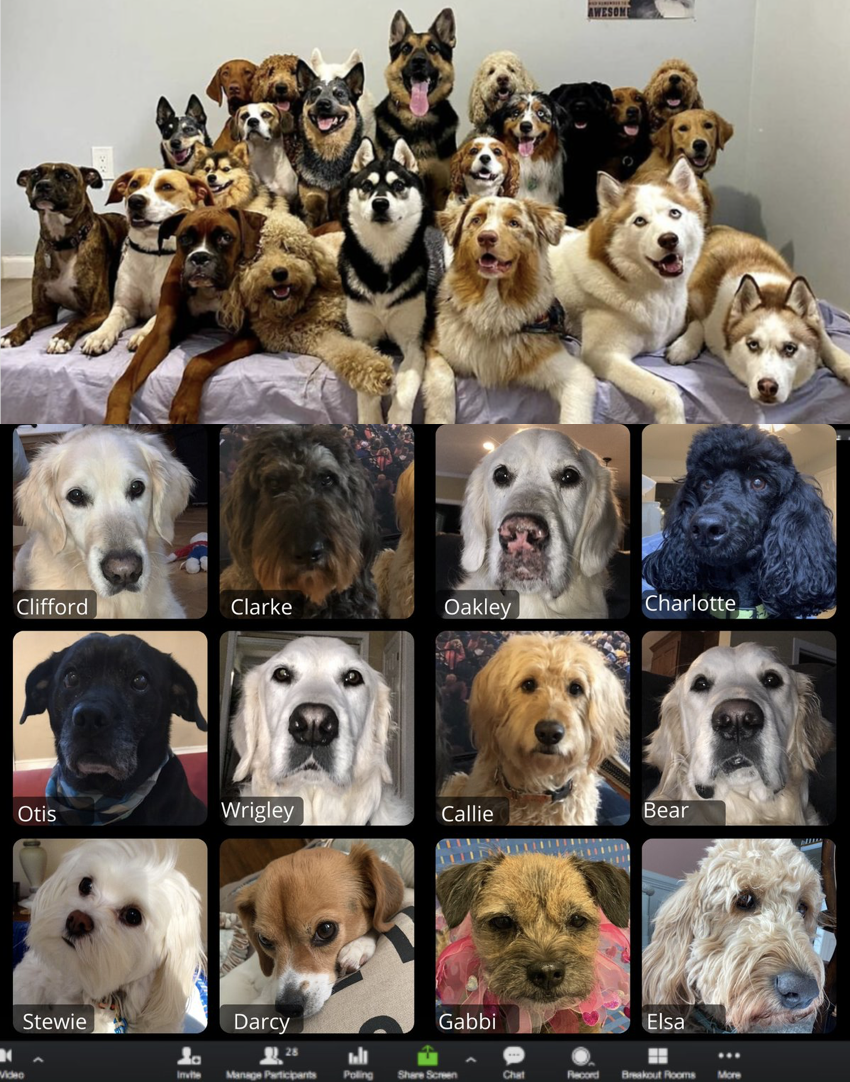Seven Steps to Great Presentations on Zoom and in the Room
Having started my career in the ‘real world’, it’s been a pleasure to run my work online via Zoom. However, now public spaces are open again, I’m leading sessions again in… well, what to call them? Real? Physical? Geolocated?! rooms as well. I love both dynamics equally. Which do you prefer?
It helps to check your appearance and background in Zoom before you open the call – Gabbi knows.
Do you like online’s focused, cosier, more aural / oral attention? Or do you favour a shared room’s pheromones / full sensory vibe?
Either way, here’s seven reminders to help you make your presentations shine, whether you’re on Zoom or in a four-walls room.
1 Prepare Your Space
Online: Definitely make sure you log into the correct Zoom account! Open the Zoom room early if you can. Set the space (tidy your WFH office behind you or add a suitable background image); print your notes; test headphones, quit out of applications for best bandwidth, test the closed captions, etc. Treat your virtual space with the same care as you would a physical space.
IRL: Visit the venue early, if possible, and walk the space so you ‘own’ it. Check tech: cables, venue log-ins, your slides, their mic, lights – and camera connections, if the event is blended. You certainly need to reset from the previous person’s AV settings! Prevent overwhelm with a mental hierarchy of outcome importance, eg. is a clean recording more important than to connect with your present audience, or vice versa?
2 Ground Yourself
Online: Having a pre-presentation ritual (breathing, vocal warm-ups, stretches) is just as crucial when you’re on Zoom as when you are in the room. Use these examples to get yourself in the zone, if you wish. Practise your first two minutes several times so as to pre-empt the inevitable adrenalin response that kicks in when you start your talk for real.
IRL: The same rituals apply IRL, of course: your body isn’t just a taxi for your brain. Throw a power pose or two (as many as it takes to stop feeling silly as you do it). Project your voice so it ‘hits the back wall’ or practise with the mic. Put handouts where you want people to sit (towards the front) so they have something to do as others arrive.
3 Check Your Appearance
Online: Even high-pressure global Zoom calls can feel oddly cosy at times, I find, since they’re only a couple of clicks away and often in your WFH office. Choose an outfit that won’t glitch with the designated client-logo background; check your self-view framing before the call by opening Zoom directly. Good hair, a necklace or an ironed shirt always helps.
IRL: Treat your presentation outfit as a uniform. Land on a look that’s classy, comfy, doesn’t say “I’m trying to be better than you”, and won’t carry stains. You can wear it every time you have a spotlight slot. As you put it on, you’ll feel like you’re ready for battle and in a ‘professional speaker’ mindset. Accessories / hair choices keep a look feeling fresh.
4 Get To Know Your Audience
Online: If possible, familiarise yourself with attendee names beforehand. A participant list often comes as standard for online and already knowing the names that’ll turn up in the room is a surprisingly strong way to lower your stress levels. We’re all just people, people! When everyone gets there, why not invite everyone to check in with each other and enjoy the whole room’s faces in Gallery View?
IRL: Read attendee names beforehand and if you can, move among (or meet) your audience before your talk: if your nerves affect your voice, this will warm you up. Even just to say your name, hear theirs, plus a quick: “Pleased to meet you” calms down an inevitable adrenaline spike of presentation anxiety. Google pronunciations of names if you’re unsure of them.
5 Amp Up Your Internal Energy
Online: With online in general, you have to turn up your internal brightness by an extra 20 percent to be received the same way as IRL. Your smile, intensity, energy and positivity levels (you don’t have to be jazz-hands: I’m talking internally here), can all stand to increase. You’ll get less instantaneous feedback: inviting people to type their reactions in the Chat can help.
IRL: A presentation is a huge conversation of one person to many and immediate feedback is a great benefit of IRL talks. However, be prepared to have your energy zapped by so many people, simply because of the unusual amounts of extra sensory processing. You might need to make more eye contact than you’ve been used to in recent times.
6 Amp Up Your External Presence
Online: The less clearly an audience can see you, the easier it is for them to switch off. It’s never too late to buy a ring light or to reconfigure your space so as to face a window. You can tweak light levels on Zoom in any meeting via Video Settings/ My Video. Audio-wise, check your mic: record a little test a few days before. It’s astonishing how often people are unaware of their poor audio quality. On the day, look directly into your camera regularly.
IRL: An audience makes judgements before you’ve even touched the mic, so seeming calm, open and warm will help you command the room. We’ve lost a lot of our wider social skills over a year and a half such that we’re now often unaware of diminishing behaviours such as crossed arms, looking away or fidgeting. Practise in a mirror beforehand and aim for calm, relaxed and happy high status.
7 Hand Over Your Space
Online: It’s hard to stop talking / switch gears when presenting online, even when you definitely want, say, a Q&A. Allowing contributions online is an art. Digital lag, less motivation to share (since people are not in the same IRL room as you), and more distractions (emails, client Slack channels) all make audiences less ‘present’. If you find it hard to hold space comfortably during digital silences, practise with friends or colleagues.
IRL: It’s easier to create room in a real-life space for audience contributions, but don’t rush it here, either. Always repeat what the person in the audience has said, because you are probably louder, with or without a mic, and the audience are by now used to your voice. Repeating a question or comment clarifies, authenticates and amplifies it for the group.


